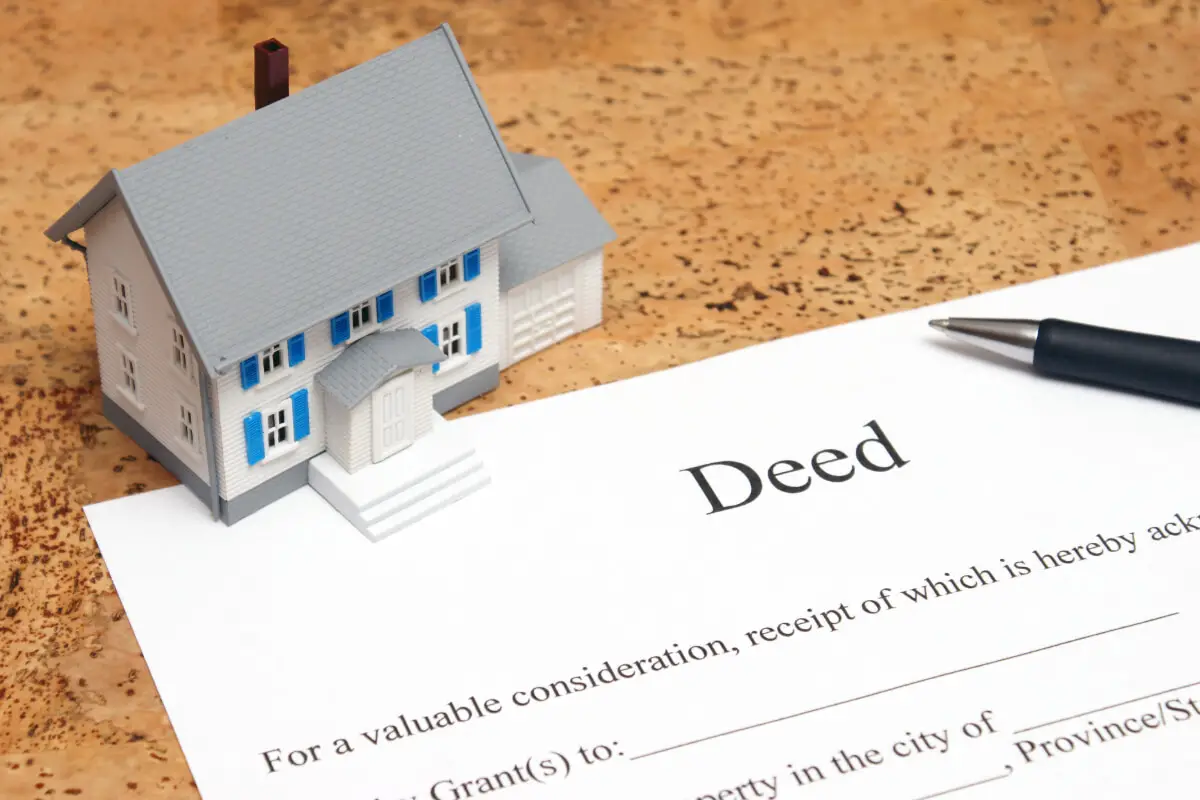At first glance, the document known as a house deed might seem merely a piece of paper, but in reality, it is a highly significant record that legally acknowledges one’s ownership of a piece of real estate. Although most people would typically encounter a house deed when buying a property, understanding the depth and complexity of this document can significantly facilitate the process of making this monumental purchase.
This writing will explore the essential elements a house deed must possess, the primary types of deeds currently utilized in the real estate market and the importance of the deed recording process.
Table of Contents
House Deed Essentials
When discussing property transfers, one document reigns supreme: the house deed. This crucial piece is the binding embodiment of the proverbial ‘handing over the keys.’ But what makes up this cornerstone document of real estate transactions? Let’s dive into the intricacies of the house deed, clearly explaining its essential elements and their functions.
First and foremost, a deed defines the parties involved in the transaction. These are typically the ‘grantor,’ transferring the property, and the ‘grantee,’ the receiving party. Without identifying these parties with their legal names and current addresses, the document lacks the necessary robustness, potentially resulting in confusion and disputes.
Next, a legal description of the property comes into focus. An accurate, detailed description is paramount, encompassing the physical address and detailed boundaries and identifiers like section, lot, and block numbers.
Commonly drawn from a plat, a map registered at the local land office, this crucial component helps delineate the specific parcel of land changing hands, eliminating possibilities of disputes.
The deed also explicitly states the ‘consideration’ involved in the transaction. Consideration, in legalese, doesn’t hint at thoughtfulness or regard, but the agreed-upon payment for property is usually distilled down to a dollar amount. This can also encompass non-monetary considerations, such as services rendered or swapped properties.
Following this, the deed outlines the type of warranty being offered. The two most common types are quitclaim deeds and warranty deeds. Quitclaim deeds, the simpler of the two, transfer ownership without any warranties regarding the title’s quality.
The grantor doesn’t claim clear title but merely transfers any interests they may hold. Conversely, a warranty deed assures the grantee that the grantor has a clear title, guaranteeing against any faults in the title, even those stemming from historical transactions.
To give the document legal effect, the grantor must sign the deed. The signature epitomizes consent, proving the grantor’s clear intention to transfer their property rights. These signatures must usually be notarized, underscoring the authenticity of the document.
In contrast to digital transactions and signatures, a deed isn’t complete until physically delivered to the grantee. This can happen via personal delivery, postal service, or using an intermediary, like an attorney.
Finally, the jurisdiction where the property is located often requires the deed’s recording. Though not technically part of a deed, recording it at the local land registrar’s office offers an undeniable public record, safeguarding both parties against disputes or insinuations of fraud.
A house deed is the physical manifestation of a property transfer, a tangible symbol of a complex legal and deeply personal process. It reflects hard work, due diligence, and the closure of one chapter as another starts — all captured within its essential elements: the parties, property description, consideration, type of title warranty, grantor’s signature, delivery, and recording.
With such significance resting on these details, it is crucial to understand the elements and importance of a deed for any potential buyer or seller in the real estate market.

Types of Deeds
The Wide Spectrum of House Deeds: Demystifying the Varieties
The labyrinth of real estate transactions isn’t confined to brick and mortar. It ventures into the realm of legal documents – house deeds. Much like the vibrant palette of property types, house deeds are diverse, each having its unique character, purpose,, and varying implications for the parties involved.
Although the deeds share essential elements like the grantor, grantee, property description, consideration, signature, notarization, delivery, and recording, it’s the type and warranty where they diverge.
The kaleidoscope of house deeds begins with the most common and secure – the General Warranty Deed. This deed serves as the grantor’s affirmation that they have clear and unrestricted ownership of the property and the authority to sell it. Besides, it includes covenants protecting the grantee against future claims to the property.
Extraordinary Warranty Deeds, a slight deviation from their general counterparts, limit the grantor’s liability. They ensure the grantee protection against only those claims arising during the grantor’s period of ownership. Thus, they present a wise choice when buying from entities that have owned a property for a limited duration.
Quitclaim Deeds, a unique breed of house deed, offers no warranties. They chiefly cater to transferring property within a family or rectifying title defects. Despite the lack of any promise of a clear title, they remain popular due to their simplicity and affordability.
Looking a bit off the beaten path, Bargain and Sale Deeds are devoid of any warranty but imply that the grantor holds the title to the property. This deed type is often seen in foreclosure and tax sales, marking their territory distinctively.
Then, the Grant Deed secures a spot on this spectrum with its limited assurance that the property hasn’t been sold to another party and no title encumbrances exist apart from those already disclosed. This deed, joint in some states, bridges the warranty gap between Quitclaims and Warranty deeds.
Lastly, within commercial real estate, Deeds of Trust, also known as Trust Deeds, reigns. Linking the borrower, lender, and a neutral third-party trustee, this deed allows the trustee to sell the property if the borrower defaults, ensuring the lender’s protection.
As dynamic as the business world, house deeds are filled with variety and nuance. In every deed, an opportunity emerges, whether to solidify a family transfer, resolve a title issue, buy during foreclosure, or ensure total protection during a property transaction.
Knowing the differences is essential to securing the most appropriate deed for every unique real estate transaction. No matter the circumstance, a keen understanding of the diverse landscape of house deeds will invariably illuminate the pathway to intelligent, strategic property investment decisions.

Understanding the Deed Recording Process
The Deed Recording Process: An In-Depth Look
The deed recording process can be laborious but convoluted, yet it is the most crucial guarantee in property transactions. A robust process, it has evolved in response to the market’s needs, promising transparency and security to all parties involved – an affirmation of the doctrine of entrepreneurship that praises innovation.
Once the rudimentary facets of the transaction have been dealt with – involving grantor, grantee, legal descriptions, consideration, and type of warranty – we move onto the following detailed steps. These further elucidate the concept, the course it takes, and how it aids in making real estate transactions more brief and secure.
The verification process is one critical step that succeeds after the delivery of the deed to the grantee but before recording it. This typically serves as a double-check of the document to ensure all information is correct. Tie discrepancies, if any, can be rectified before they’re recorded, cementing future disputes.
Post verification, input from an impartial party or an escrow agent is considered. This agent thoroughly reviews the deed for potential legal descriptions or name errors, ensuring everything aligns with the prior mutual agreement. Having an impartial party lends credibility to the process.
The process gains more authentication when the County Clerk’s or Recorder’s Office checks for additional factors, particularly tax liabilities. If unpaid taxes or liens are present against the property, the deed recording may be halted until these obligations are fulfilled. This critical step shields the grantee from assuming any preceding financial liabilities of the property.
Finally, we arrive at fee payments. Recording the document at the local land registrar’s office comes with a cost, depending on the state and county. This nominal fee typically covers costs associated with maintaining these public records. Understanding these fees upfront helps keep transactions transparent without unexpected financial missteps.
What’s notable about the final deed recording stage is the prestige it accords to the grantee. The physical location of the land registrar’s office, where the deed is ultimately recorded, is significant as it provides an ‘official’ tag. When the deed is recorded, the ‘public notice’ indicates that property ownership has changed hands.
The entire process must match the type of deed involved – General Warranty Deeds, Special Warranty Deeds, Quitclaim Deeds, Bargain Sale Deeds, Grant Deeds, or Deeds of Trust. Each has its quirks and nuances, making understanding these deed types imperative for a successful transaction.
Overall, the deed recording process is an elegant mix of procedure, law, and technology that ensures fair property transactions. It’s more than a workflow; it ascertains accountability and safeguards everyone’s interests.
Understanding this process is essential in leveraging real estate’s potential and broader market dynamics as property transactions evolve and the business realms are continually redefined.

Indeed, possessing an in-depth understanding of a house deed and its varying types can significantly simplify buying a property, eliminate possible disputes, and safeguard your rights as a property owner.
Whether grasping the importance of every essential element in a deed, navigating through the types of deeds, or comprehending the deed recording process, every aspect is pivotal to your journey in property ownership. With such knowledge, your future real estate dealings will significantly be enhanced, mitigating potential stress and confusion.
Real Estate Crunch gives you real property and real estate information and advice. We offer a free monthly newsletter; you can sign up for our newsletter by clicking here.
We also have a weekly podcast called “Real Estate Crunch,” found on all major podcast platforms. Listen to our podcast by clicking here.
Follow us on our social media platforms – Facebook and Instagram.
Related Questions
What Is Joint Tenancy In Property Transactions?
If you want to purchase property with another person, one of your options is to have a Joint Tenancy agreement for your property transactions.
A Joint Tenancy in a property transaction is when all parties in Joint Tenancy have equal shares and obligations for the property. One of the unique aspects of the Joint Tenancy agreement is the right of survivorship.
By clicking here, you can read more about What Is Joint Tenancy In Property Transactions?
5 Tips To Being A Good Roommate
To be a good roommate, you should learn to communicate with your roommates. It is good if roommates can sit down and go over ground rules. Learn to clean up your messes and respect the privacy and personal property of others. Also, let your roommate know if you will have guests over and be respectful of them and their schedules.
By clicking here, you can read more about 5 Tips To Being A Good Roommate.
What Is An Underwater Real Estate Mortgage?
An underwater mortgage, also known as an upside-down mortgage, is when your home or property value decreases so much that you now owe more to the bank on your mortgage than what the home is worth. There are many reasons why an underwater mortgage can be problematic for homeowners.
By clicking here, you can read more about What Is An Underwater Real Estate Mortgage?


